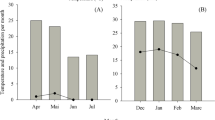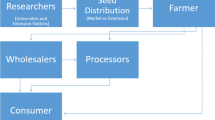Abstract
In 1988, the IRA-CIP potato project was created in Bambui, Cameroon, with the major objective of improving potato production in the country. In 1992, two potato cultivars, Cipira and Tubira, were released by the project. In 1998, a socioeconomic impact study of Cipira and Tubira was carried out in the main potato-producing region of Cameroon to determine the reaction of the farmers, the effect of the new potato cultivars on the farmers’ standard of living, and the level of achievement of the project’s objectives.
Data were collected on-farm using questionnaires and direct observations. An impact survey was carried out in the region with a sample of 297 farmers selected among the potato farmers using stratified random sampling. The survey indicated that 98.6% of the potato farmers were aware of the new potato cultivars. Their main source of information was other farmers (51.5% of farmers informed). Seventy-eight percent of the farmers were still using Cipira and 62% had adopted it as part of their production system. These farmers (62.6%) reported that the resistance of Cipira to late blight was higher than that of local and European cultivars used in their production system. More than 44% of the farmers believed that their standard of living had improved due to Cipira and Tubira, since they had generated more revenue to improve their family education and nutrition, build more houses, buy more farms, purchase more farm inputs, and open new businesses. In addition, the farmers’ average yearly potato production increased from 1.6 to 3.1 tons during the period when these varieties were being adopted.
Resumen
En 1988, se creó en Bambui, Camerún el IRAD-Proyecto de Papa del CIP con el objetivo principal de mejorar la producción de papa en el país. En 1992, el proyecto liberó dos cultivares de papa, Cipira y Tubira. En 1998, en la principal región productora de papa de Camerún se realizó un estudio acerca del impacto socio económico de ambas variedades para determinar la reacción de los agricultores, los efectos de los nuevos cultivares en el estandar de vida de los productores y el nivel de objetivos alcanzados por el proyecto.
Los datos fueron recogidos mediante encuestas en campo y observaciones directas. Se realizó una encuesta de impacto entre 297 agricultores de la región, quienes fueron seleccionados usando muestreos estratificados al azar. La encuesta arrojó que el 98.6% de los agricultores de papa estaban enterados de los nuevos cultivares. Su prinipal fuente de información eran otros agricultores (51.5% de los encuestados). Setenta y ocho por ciento de los agricultores todavía seguían usando Cipira y 62% la habían adoptado como parte de su sistema de producción. Esos agricultores (62.6%) señalaron que la resistencia de Cipira al tizón tardío era más alta que los cultivares locales y europeos usados en sus sistemas de producción. Más del 44% de los entrevistados creían que sus estándares de vida se habían elevado gracias al uso de Cipira y Tubira, debido a que les habían generado mayores ingresos para mejorar la nutrición y educación de sus familias, construir más casas, comprar más tierras, adquirir más insumos agrícolas y abrir nuevos negocios. Además, el rendimiento promedio de la producción de papa de los agricultores se había incrementado de 1.6 a 3.1 t durante el período de adopción de esas nuevas variedades.
Similar content being viewed by others
Literature Cited
Adhiambo O. 1993. Planning a seed potato program, the case of IRA-CIP potato project, Cameroon.
Demo P. 1997. Effect of diffrent seed tubers sizes on potato (Solanum tuberosum L) yield. M. Sc. Thesis, University of Ibadan, Nigeria.
Devaux A, and AJ Haverkort. 1986. Manuel de culture de la pomme de terre en Afrique Centrale. PRAPAC, International Potato Center, Lima, Peru.
Foncho PAF. 1989. Future plans and strategies for potato research in Cameroon.In: Potato Production and Constraints in West and Central Africa: Overview and Planning Strategies for the Future. Report of the workshop held at Bamenda, Cameroon. 25–30 September 1989. International Potato Center, Lima, Peru. p. 59.
Gass T, and J Lekunze. 1990. Cameroon national potato and sweet potato survey. International Potato Center, West and Central Africa, Bamenda, Cameroon.
IRA-CIP. 1995. Improved potato varieties for Cameroon. Technical bulletin No 1, IRA-CIP, Bamenda, Cameroon.
Martin C, P Demo, D Njualem, T Gass, and C Ntonifor. 1995. Late blight resistant varieties for Cameroon. Am Potato J 72:513–522.
MINAGRI (Ministry of Agriculture). 1984. Year book of Agricultural statistics, MINAGRI, Yaounde, Cameroon.
Ngu J. 1984. Educational needs for rural manpower development in Cameroon: some problems of rural human capital formation. Proceedings of the seminar on the role of rural organizations in the process of development. University Centre of Dschang, Cameroon, July 15–21, 1984. 1:133–148.
Njualem D, HA Mendoza, JT Koi, P Demo, V Deffo, and FS Nana. 2000. Evaluation of twelve potato varieties in the Northwestern highlands of Cameroon. Root Crops in 21st Century, 466–471.
Tchala-Abina F. 1984. Interventionnisme et dépaysannisation dans les stratégies de Développement agricole en Afrique: un point de vue critique. Proceedings of the seminar on the role of rural organizations in the process of development. University Centre of Dschang, Cameroon, July 15–21, 1984. 1:107–120.
Tumanteh AJ. 1968. Production and post-harvest technologies of root and tuber crops in the North West Province of Cameroon. Rome: FAO of the United Nations.
Author information
Authors and Affiliations
Corresponding author
Rights and permissions
About this article
Cite this article
Deffo, V., Njualem, D., Koi, J. et al. Socioeconomic impact of two potato varieties (Cipira and Tubira) released in Cameroon. Am. J. Pot Res 80, 151–158 (2003). https://doi.org/10.1007/BF02855687
Accepted:
Issue Date:
DOI: https://doi.org/10.1007/BF02855687




